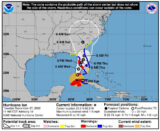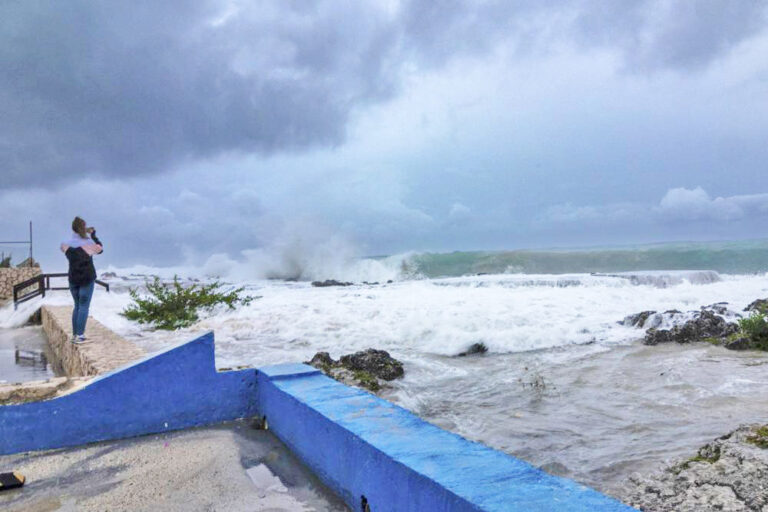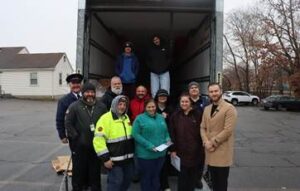TALLAHASSEE, Fla. — Florida Gov. Ron DeSantis has waived weight and size requirements for any vehicles transporting fuel, emergency equipment, services, supplies and agricultural commodities and citrus ahead of what’s expected to be a devastating Hurricane Ian.
Florida Department of Highway Safety and Motor Vehicles (FLHSMV) has issued has issued Emergency Order 092422, which waives specific requirements for commercial motor vehicles providing emergency relief and waives the replacement fees for driver’s license and identification credentials, vehicle registrations and titles, vessel registrations and titles and temporary parking permits for impacted individuals.
Florida Highway Patrol officials said they are in close communication with law enforcement and transportation partners and stands ready to assist for any potential impacts across the state.
The Florida Department of Transportation (FDOT) is conducting, or has completed, standard pre-storm preparations such as:
- Preparing Emergency Shoulder Use (ESU) corridors for needed future activation.
- Inspecting and clearing roadways.
- Securing maintenance yards, active projects and barges, facilities, and high mast lighting.
- Checking and clearing drainage areas and inlets.
- FDOT continues to monitor roadways, bridges, airports, seaports, railroads, transit systems, and other critical infrastructure.
Hurricane Ian tore into western Cuba on Tuesday as a major hurricane, with nothing to stop it from intensifying into a catastrophic Category 4 storm before it hits Florida on Wednesday.
Ian made landfall at 4:30 a.m. EDT Tuesday in Cuba’s Pinar del Rio province, where officials set up 55 shelters, evacuated 50,000 people, rushed in emergency personnel and took steps to protect crops in Cuba’s main tobacco-growing region.

The U.S. National Hurricane Center said “significant wind and storm surge impacts” were occurring Tuesday morning in western Cuba. Ian sustained top winds were 125 mph and as much as 14 feet of storm surge was predicted along Cuba’s coast.
Ian was forecast to strengthen even more over warm Gulf of Mexico waters, reaching top winds of 140 mph before making landfall again.
Tropical storm-force winds were expected in Florida late Tuesday, reaching hurricane force Wednesday morning.
“Right now we’re focusing on west central Florida area as the main area for impact,” hurricane specialist Andy Latto told The Associated Press on Tuesday.
“This is a really really big hurricane,” Florida Gov. Ron DeSantis said, warning of damage all across the state.
Hundreds of thousands of Floridians faced mandatory evacuation orders as the center expanded its hurricane warning to include Bonita Beach north through Tampa Bay to the Anclote River. Fort Myers is in the hurricane zone, and Tampa and St. Petersburg could get their first direct hit by a major hurricane since 1921.
Meanwhile, the American Logistics Aid Network is urging Florida and Gulf Coast residents to prepare — and asking members of the logistics community who aren’t located near the storm’s path to be ready to help.
“Over the next few days Hurricane Ian has the potential to deliver high winds, strong rains and a significant storm surge across many parts of Florida,” Kathy Fulton, ALAN’s executive director, said. “We are mobilizing accordingly.”
Late last week, ALAN began what Fulton calls the preparedness stage of the disaster relief organization’s storm activation, which includes:
- Providing pre-storm information about the storm’s latest path and supply chain impacts via its Supply Chain Intelligence Center, which can be accessed for free at www.alanaid.org/map.
- Updating ALAN’s Disaster Micro-site with helpful links for those who are in Hurricane Ian’s cone of concern. That site is also where ALAN will share any specific requests for logistics assistance that it receives because of the storm.
- Checking in with members of the nonprofit and disaster relief community to find out what resources they anticipate needing.
- Working closely with government and industry officials to share critical disaster and supply chain information.
ALAN’s response relief efforts — which include fielding and filling specific requests for logistics help — will commence later this week if the storm’s strength and path continue as predicted.
“Most of our requests for assistance arrive after a hurricane or tropical storm has hit,” Fulton said. “That’s because each storm winds up having very different outcomes and pain points. And you really can’t predict what those will be – and where relief organizations will require supply chain assistance the most – until after the storm has moved through.”
As always, Fulton said that ALAN hopes these measures will prove to be merely precautionary.
“Over the years we’ve seen some potentially catastrophic hurricanes that have turned into relatively minor events while others have morphed into far more deadly and destructive events than expected,” she said. “We are praying that Hurricane Ian will turn out to be the former. However, if it isn’t, we want people to remember that ALAN is here to help – and to do everything in their power to keep themselves and their loved ones safe.”
Solera Fleet Solutions/Omnitracs offers the following hurricane safety tips for truck drivers:
Don’t forget to prepare for the before, during and after. Before a hurricane hits, there are various ways drivers can prepare themselves and their cabs for the storm. Drivers can — and should — prepare for the worst-case scenarios, including getting caught in the middle of the hurricane or its aftermath.
While it is always imperative that drivers aim to be off the road during a hurricane, they should get off the road as slowly and carefully as possible if they find themselves stuck in one. While driving during and after a hurricane, avoid driving through pools of water. Standing water can hide fallen power lines and sinkholes and may look far less deep than it is.
Get ahead of the weather and route. The National Weather Service will issue three different kinds of alerts with impending hurricanes. The first alert is an advisory, which signifies potentially hazardous, but mostly non-life-threatening inconveniences. The second alert is a watch, which indicates a potential tropical storm or hurricane within 48 hours. The third and most crucial alert is a warning signifying an impending tropical storm or hurricane within 36 hours.
If driving in areas that are potentially sensitive to hurricanes, drivers should look through their planned route before they go to stay in the know on how to prepare best. If driving through one of these areas, be sure to tune into the local weather radio station and continuously monitor weather updates.
Remember that safety and flexibility go hand in hand. Nothing is worth jeopardizing personal safety or the safety of others. The sheer weight and size of commercial motor vehicles, coupled with weather-related incidents, can result in massive disasters on the road.
Any reasonable customer or manager should and must understand that safety is the top priority while drivers are on the road, so keep a flexible mentality. Communicate delays to routes as needed; remember, slow and safe is better than fast and sorry.
Practice open communication. While experienced fleet managers and dispatchers prioritize driver safety, they’re not in the driver’s seat. Drivers should keep the lines of communication with them open, so they know what drivers see when they see it.
Open communication also helps back-office teams reroute drivers as needed, so they can further avoid dangerous routes altogether.
Equip the truck with the right necessities. Drivers should ensure their cab is fully stocked with the proper necessities on the road.
Here are the vital supplies drivers will want to keep on hand:
- Bottled water and non-perishable food.
- Rain gear, such as umbrellas, ponchos, and boots.
- A pack of different types of batteries.
- A flashlight or headlamp.
- A portable phone charger.
- Protective cold-weather gear, including gloves, warm clothing, and blankets.
Other hurricane safety tips and resources are available from the National Weather Service.
The Associated Press contributed to this report.
The Trucker News Staff produces engaging content for not only TheTrucker.com, but also The Trucker Newspaper, which has been serving the trucking industry for more than 30 years. With a focus on drivers, the Trucker News Staff aims to provide relevant, objective content pertaining to the trucking segment of the transportation industry. The Trucker News Staff is based in Little Rock, Arkansas.















